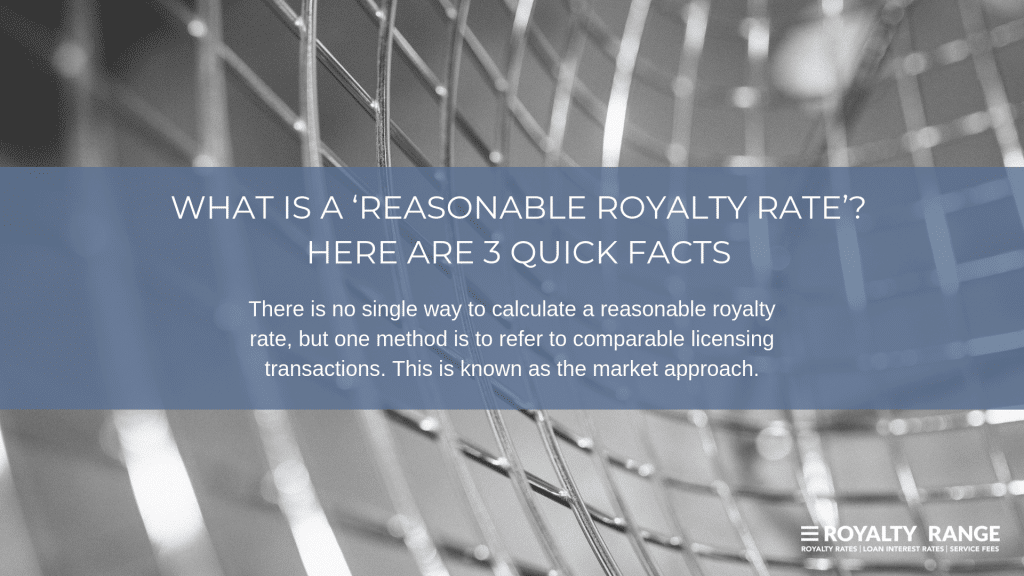What is a ‘reasonable royalty rate’? Here are 3 quick facts

Kris (Kestutis) Rudzika |
August 14, 2019

A ‘reasonable royalty rate’ is an estimation of damages in patent infringement cases. It is often referred to as established royalty that a licensee would pay for the rights to the patented invention in a hypothetical negotiation. There is no single way to calculate a reasonable royalty rate, but one method is to refer to comparable licensing transactions. This is known as the market approach.
Here are three quick facts about the estimation of the reasonable royalty rates.
1. Reasonable royalty rates are used in patent infringement cases
Patent infringement occurs when an individual or organization uses an inventor’s patented product or method without their permission. If a patent owner has licensed their patent rights to a licensee, and the licensee breaches the terms of the patent license agreement, this is also infringement.
If a patent owner’s intellectual property rights have been infringed, they can take the infringer to court. The court will determine appropriate compensation that the infringer must pay the claimant.
In patent infringement cases, the claimant has two choices for determining damages:
- A ‘lost profits’ claim: If the claimant is able to prove the profits it would have earned had the infringement not occurred, they may be able to claim that amount as damages.
- The ‘reasonable royalty rate’ approach: This approach is often used where lost profits cannot be proven. It provides the claimant with a market-based rate.
The most appropriate option depends on the individual circumstances of the infringement case.
2. There is no single method for calculating a reasonable royalty rate
When it comes to calculating a reasonable royalty rate, there is no one-size-fits-all method. In fact, the laws, guidelines and techniques surrounding reasonable royalty rates are constantly evolving.
Here are some of the most common frameworks you can use to determine reasonable royalties for a patented invention:
- Market approach: If you have access to suitably comparable licensing agreements, you can base the reasonable royalty rate on the royalties earned in comparable transactions. In order to use the market approach, the third-party licensing data must meet strict technical and economic comparability criteria. Remember that royalties can be affected by factors including industry, market size, product growth potential and the nature of the licensed IP. Use the RoyaltyRange database today to find real comparable royalties for your analysis.
- The Georgia-Pacific/hypothetical negotiation approach: This method involves carrying out a hypothetical license negotiation between a ‘willing licensor’ and a ‘willing licensee’. It was developed through the case of Georgia-Pacific Corp v. United States Plywood Corp in 1970. The method outlines 15 factors that you can use to determine a reasonable royalty rate through the hypothetical negotiation framework. These include the royalties received by the licensor for the patent, the commercial considerations of both parties, the profitability of the product using the patent and the value the patent has brought to the infringer.
- Analytical approach: This involves identifying the infringer’s projected profits for the patent in question at the time of the infringement. These projected profits are then split between the relevant parties as a percentage of sales, and the claimant’s percentage is applied to the actual sales during the infringing period to determine the appropriate damages.
These are only quick overviews of some of the available calculation methods.
Patent licensing and patent infringement cases are complex, so it’s important to consider each method carefully and take into account the unique circumstances of the case.
3. Comparable licenses are a good starting point for any analysis
If you use the market approach, you will need to draw on comparable royalties drawn from real, up-to-date license agreements. The quickest way to find reliable data is to use RoyaltyRange database.
Whatever method you choose for determining reasonable royalty rates, comparable licensing transactions offer a good starting point for your analysis. They enable you to see the royalties agreed for comparable licenses in real market transactions, giving you a basis for your calculation.
You can search the RoyaltyRange database to find recent third-party license agreements quickly and easily. Simply enter your comparability criteria below and we’ll provide the relevant results.
Search for comparable patent royalties today
Ready to use our database? Go to the bottom of this page, where you’ll find our purchase forms.
You can choose from the following services:
- One Search: Access the database on a one-off basis. No subscription needed.
- Readymade One Search reports: Download one of our pre-prepared royalty reports for your industry.
- Subscription: Sign up for 12 months’ unlimited access to our royalty rates data.
- Benchmarking study: Get an in-depth report that compares relevant royalty rates for your product and industry. See averages and the interquartile range.
- Readymade benchmarking study: Download one of our pre-prepared benchmarking studies for your industry.
Request One Search
We will perform the search and deliver the initial results within hours, at no cost.




